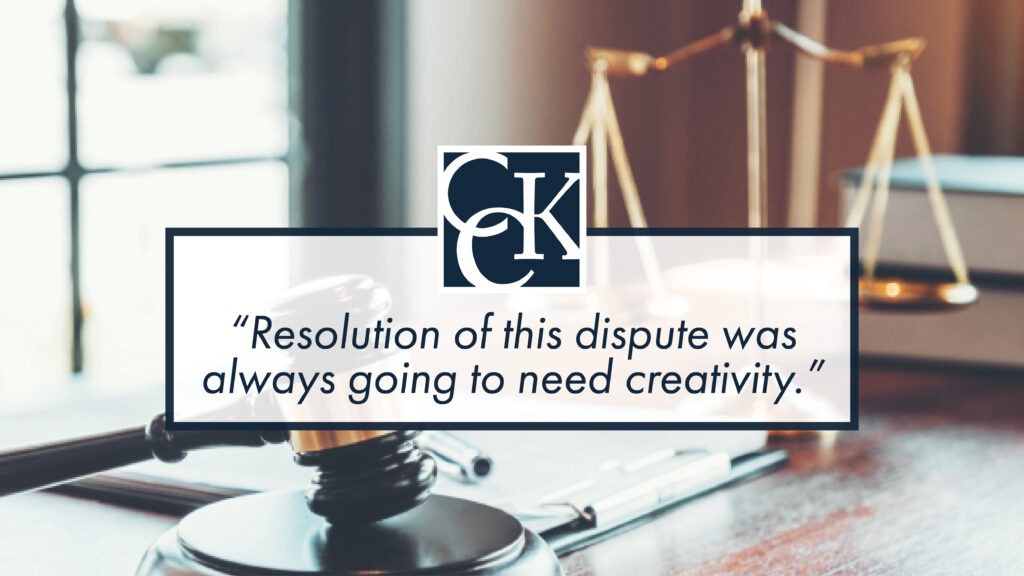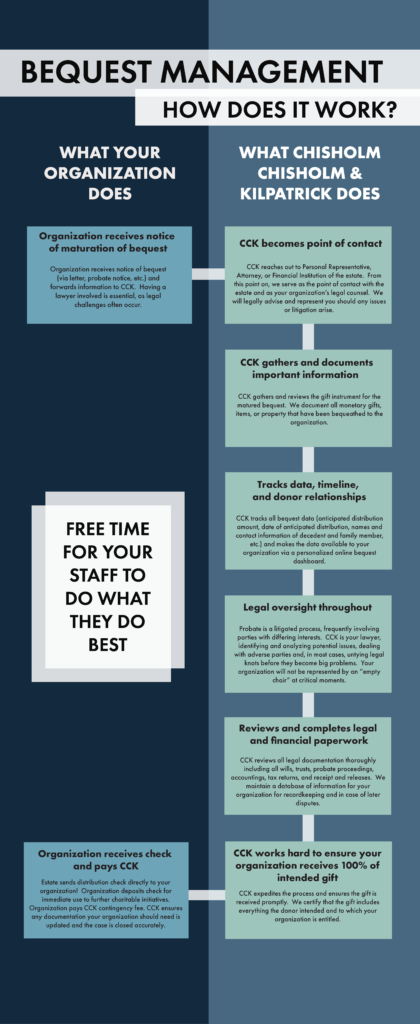Real Estate Bequests: Take Title or Hold Out for Proceeds?

A Beleaguered Trustee, Five Charities, Four Properties, Two Trusts, and Millions of Dollars
The recent case of Stadel Art Museum v. Mulvihill, 96 Cal.App. 5th 283 (2023) involves five charities sharing a bequest of four San Francisco properties (“Properties”). It sounds simple, but it was not. The Stadel case is a good example of the range of issues that can arise from real estate gifts, especially shared gifts.
The Story
Boesch and Hudson were life partners and investment partners. Boesch died in 1995 and Hudson died in 2019. With both deceased, their separate assets were in two trusts, each of which held a 50% interest in the Properties, which Boesch and Hudson bought years earlier and managed as rental units. Mulvihill was the trustee of both trusts and responsible for the administration of both estates.
Boesch’s trust left his “half” of the Properties to the Stadel Art Museum, located in Germany. Hudson divided his half among four U.S.-based charities (SF Conservatory of Music, SF-Marin Food Bank, International House at UC-Berkeley, and the National LGBTQ Task Force) (hereafter, the “Hudson Charities”).
The battle lines emerged quickly. Stadel demanded that Mulvihill distribute the Properties “in kind” (i.e., by deed) to the charitable beneficiaries. The Hudson Charities were equally insistent that he sell the Properties and divide the proceeds into the proportions established in the trusts.
Poor Mulvihill was stuck right in the middle. Either decision he made would leave one side elated and the other side furious. Even worse, Mulvihill was in the unenviable position of owing suddenly conflicting fiduciary duties to Stadel (under the Boesch Trust) and the Hudson Charities (under the Hudson Trust).
Mulvihill could not cajole the beneficiaries into a settlement and asked the court to tell him what to do. Unfortunately, his “request for instruction” did not provide the guidance he sought. After considerable litigation, the appellate court sent the case back to the probate court with directions (1) to determine if Mulvihill should resign as trustee for one of the trusts and (2) if not, to order him to decide and do something.

Making Sense of the Dispute
Why would Stadel (which is in Germany!) want to take ownership of a 50% interest in the properties instead of just receiving the cash?
It is true that most charities will take cash-over-deed any day. However, Stadel’s adamant stance here is quite understandable. When a trust sells real estate, it must pay tax on the gain in value from the time of the trustor’s passing. In the quarter-century between Boesch’s death and this case, the value of the 50% share earmarked for Stadel had increased greatly. In practical terms, this means that any cash realized from the trust’s sale of the Boesch share would be subject to substantial taxes, thereby effectively reducing the bequest to Stadel. If Stadel took title instead of after-tax sales proceeds cash, it could, as a tax-exempt organization, sell its interest in the Properties with no tax consequences and thereby increase the value of the bequest.
Charities know that executors and trustees are often unwilling to sell properties. While this may sometimes be due to simple inertia, it is often related to the tax issue that Stadel identified. In short, estates and trusts are subject to income taxation on the sale of real property. Charities are not.
CCK Point to Ponder
We did not have access to the underlying documents in this case and are relying on the public file. Therefore, we do not know if there were any estate tax issues involved. Regardless, Stadel’s presence is a reminder of a frequently overlooked point that can occasionally be important for bequest managers. While contributions to foreign charities like Stadel are usually ineligible for income tax deductions, bequests to such charities do receive favorable estate tax treatment.
Why Would the Hudson Charities Insist on the Sale of the Properties as Opposed to Transfer?
The filings we have seen by the Hudson Charities dispute Stadel’s contention that the Boesch Trust mandated the transfer of the Properties. There is little, if any, specific discussion of why cash would be better for the Hudson group. However, it is not difficult to speculate why they would resist taking title:
- Since Hudson’s death was recent, the Hudson Charities’ share of the proceeds of sale would not be subject to the same level of taxation as the Boesch share;
- Apart from the ever-present environmental and liability issues with real estate, the Properties are rental properties and thus require property management, which is a burden (financially and otherwise); and
- Stadel’s proposal would involve the creation of a tenancy-in-common among the five charities and all the problems associated with “management by committee.”
Why Not Distribute Stadel’s Share “In Kind” and Sell the Hudson Charities’ Share?
This solution sounds promising but collapses in the real world. Stadel’s share of the Properties, as well as that of the purchaser of Hudson Charities’ portion, would then be fractional interests. Such interests usually sell for less and take longer to market than the more familiar 100% ownership (known as “fee simple”) interests. Owning part of a property is not appealing, unless the co-owners have an existing relationship, as did Boesch and Hudson. The “make everyone happy” solution (sell half and transfer half) would have reduced the “net” bequests to all the charities.
Was Mulvihill Guilty of Misconduct in Staying On as Trustee of Both Trusts?
Interesting question. We do not believe he was. There is certainly no facial inconsistency between the trusts that would have caused Mulvihill to decline the double role from the outset. The conflict arose later because of the differing situations and demands of Stadel and the Hudson Charities. Even then, Mulvihill had no personal conflict, i.e., he did not stand to gain by implementing one solution rather than another. At worst, Mulvihill found himself trapped in a lose-lose situation that he may not have anticipated.
Separate trustees would not have provided an instant solution to the problem. The competing, conflicting positions of the beneficiaries would remain. In a sense, Mulvihill was well-positioned to function as a mediator between the two trusts. Had different trustees administered the estates, it is hard to see how the situation would have improved. Those fiduciaries would simply have been at loggerheads, reflecting the underlying conflict between the beneficiaries. Mulvihill had a much better chance of succeeding as an “honest broker.”
The problem here is that the separate trusts were holding the same asset(s) for beneficiaries with distinctly different interests. It is easy to pontificate, with the benefit of hindsight, that Mulvihill should have just picked one method of distribution and gotten the job done. The Stadel opinion suggests that the court would have backed Mulvihill’s decision, whatever it was. However, it is likely that years of litigation would have ensued. Moreover, as the trustee of both estates, he was certainly trying to avoid any appearance of bias towards one side or the other. Resolution of this dispute was always going to need creativity.

What Kind of Solution May Have Worked Here?
We certainly have no way of knowing what negotiations have occurred or may still be occurring. Trust administration is far less public than routine probate of a will. It would be unfair to critique Mulvihill’s effort based on incomplete information.
Subject to the preceding limitation, and based solely on the information we have, the following are paths to resolution that suggest themselves in this kind of case. It will be evident that these alternatives would require a good-faith agreement between the trusts and consent from the affected charities. Ironically, Mulvihill’s “two hats” may have enhanced his chances to shepherd an unorthodox compromise.
Stadel Take Full Title to All or Some Properties
Since Stadel pressed for distribution in kind, it may have been possible to work out a settlement in which it accepted title to the Properties, thereby avoiding any taxes on subsequent sale. Stadel could then make the Hudson Charities whole via cash payment, after disposing of the assets.
A variant of this approach might involve determining if one or two of the units represented roughly 50% of the overall value of the Properties. The trusts could then transfer those to Stadel, sell the remaining Properties for the benefit of the Hudson Charities, and have a final accounting and cash transfers to even things out in the end.
CCK COMMENT
Based on what we know, Stadel would have suffered a significant loss by a sale prior to distribution. The Hudson Charities were not in similar jeopardy.
Utilize Third-Party DAF
A cleaner, and easier, version of the “Stadel Take Title” solutions would involve one of the donor-advised funds (DAF) that accepts various noncash assets on behalf of other charities. These DAFs have special expertise in all the administrative details involved in the liquidation of such property. The DAF then distributes the proceeds to the actual beneficiaries, less the costs of the transaction (which are always involved) and a modest fee.
(This arrangement is especially good for charities that are gun-shy about accepting real estate. This aversion usually stems from caution about environmental risks and administrative burdens. When a DAF is involved, it takes title and does all the work, so the actual beneficiary avoids risks and burdens and receives a check at the end of the process.)
The DAF solution would eliminate the concerns of both Stadel and the Hudson Charities. Since the DAF is itself a charity, there would be no income tax on the sale of the Properties, thereby addressing Stadel’s issue. All beneficiaries of the trusts would receive their benefit in cash, thereby satisfying the Hudson group.
CCK COMMENT
Despite the value that the asset liquidation DAFs can offer, charities are often unaware of this option, or have suspicions about its legitimacy.
We can provide reliable referrals for any organization that wishes to explore this possibility. Simply send an email to [email protected] and ask us to contact you about “liquidation DAFs.”
In our judgment, the complexities of this case invited a solution involving a DAF. In fact, charities that do not wish to avoid taking title to real estate would do well to consider the DAF solution, which is often overlooked. Normally, these organizations require that subject properties have a minimum value (often in the $200,000 to $300,000 range). The processing fee is typically less than 5% of the property value, and frequently under 3%. Naturally, ancillary costs involved with the transaction are deducted from the final amount paid, but those fees are always associated with property sales.
How Did the Story End?
The appellate court remanded the case to the Alameda County (California) Probate Court. The available public records do not give any indication of a resolution, or of significant activity. It is quite possible that negotiations are ongoing. Liquidation of the four properties involved may be difficult and time-consuming, so it is not surprising that movement is slow.
The Stadel case provides a real-life example of the complexities that can arise when a bequest consists primarily of real estate, especially if there are multiple beneficiaries. Nonetheless, the Properties have a combined value well into seven figures, so the task of untangling the knots is worth the effort.
Noncash bequests of all types are a significant asset class for charitable bequests. More organizations are realizing that fact and developing gift acceptance policies and procedures that will facilitate their ability to receive such gifts and utilize the significant value they offer in support of the charitable enterprise.
